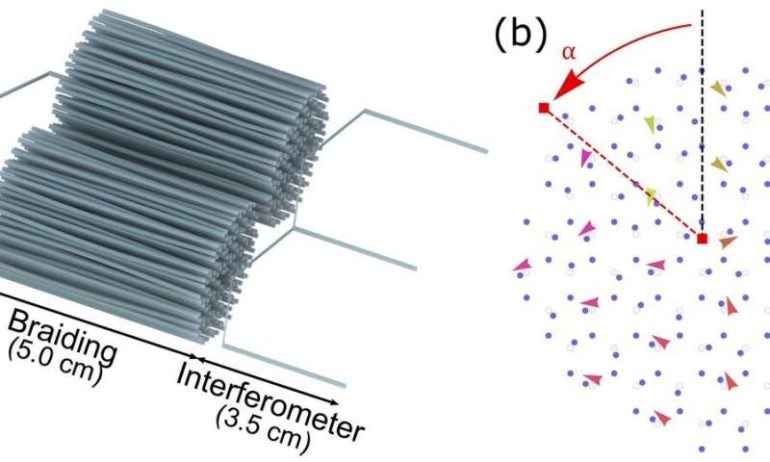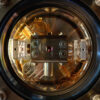Physics theory suggests that exotic excitations can exist in the form of bound states confined in the proximity of topological defects, for instance, in the case of Majorana zero modes that are trapped in vortices within topological superconducting materials. Better understanding these states could aid the development of new computational tools, including quantum technologies.
One phenomenon that has attracted attention over the past few years is “braiding,” which occurs when electrons in particular states (i.e., Majorana fermions) are braided with one another. Some physicists have theorized that this phenomenon could enable the development of a new type of quantum technology, namely topological quantum computers.
Researchers at Pennsylvania State University, University of California-Berkeley, Iowa State University, University of Pittsburgh, and Boston University have recently tested the hypothesis that braiding also occurs in particles other than electrons, such as photons (i.e., particles of light). In a paper published in Nature Physics, they present the first experimental demonstration of braiding using photonic topological zero modes.
“The idea was inspired by a well-known architecture for building a quantum computer; one that has been theoretically predicted but never experimentally realized,” Mikael C. Rechtsman, one of the researchers who carried out the study, told Phys.org. “To perform operations in this previously theorized type of quantum computer, Majorana fermions are moved around one another—this is called braiding. In a previous theoretical study, some of my colleagues predicted that braiding is a general phenomenon that can be applied not only to electrons, but to photons, as well. In our new paper, we demonstrate this experimentally, using an array of waveguides that are similar to fiber optic cables.”
Rechtsman and his colleagues measured the geometric phase of the braiding phenomenon by conducting an experiment in which two different braiding processes interfered with one another. In one of these processes, topological defects were braided clockwise, while in the other one, they were braided counterclockwise.
Interference is a feature of wave mechanics that is often used to study physical systems. This feature is responsible for countless wave-related phenomena, ranging from rainbow swirls on soap bubbles to gravitational waves.
“We observed that the light from the two opposite braiding processes interfered destructively, which confirmed our theoretical prediction that the processes have a relative braiding phase of pi,” Thomas Schuster, another researcher involved in the study, told Phys.org. “Crucially, due to the particularly simple action of braiding, the measurement we collected allows us to extrapolate the behavior of any braiding process. In particular, it verifies that when performing multiple braids in a row, the order of the braiding matters.”
Rechtsman, Schuster and their colleagues demonstrated the existence of a generalizable braiding process that they refer to as non-Abelian braiding, which is a simple manifestation of a feature that researchers have sought for in electronic systems for several years. Their results suggest that braiding may, in fact, be a common phenomenon that reaches beyond electrons and also applies to light, sound, water and potentially even seismic waves.
In addition to highlighting the possibility of using photonic lattices as a platform to study topological defects and their braiding, this study could inspire other research teams to examine braiding in the context of other phenomena that involve the production of waves. Rechtsman, Schuster and their colleagues now plan to continue investigating the braiding of photonic topological zero modes, along with other topological phenomena that could also be applied to light-related systems.
“Braiding is a topological phenomenon that has been traditionally associated with electronic devices,” Rechtsman said. “We now hope to show that a whole class of topological phenomena can potentially be useful not only for electronic devices, but also photonic devices, such as lasers, medical imaging devices, telecommunications systems, and others. We also expect that this new type of topological physics could be applied to quantum information systems, particularly those based on photons.”
Jackiw-Rebbi zero-mode: Realizing non-Abelian braiding in non-Majorana system
More information:
Jiho Noh et al. Braiding photonic topological zero modes, Nature Physics (2020). DOI: 10.1038/s41567-020-1007-5
Thomas Iadecola et al. Non-Abelian Braiding of Light, Physical Review Letters (2016). DOI: 10.1103/PhysRevLett.117.073901
2020 Science X Network
Citation:
The first demonstration of braiding in photonic topological zero modes (2020, October 9)
retrieved 9 October 2020
from https://phys.org/news/2020-10-braiding-photonic-topological-modes.html
This document is subject to copyright. Apart from any fair dealing for the purpose of private study or research, no
part may be reproduced without the written permission. The content is provided for information purposes only.



